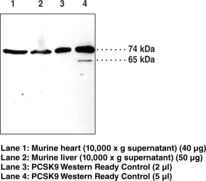服务热线
021-60498804
产品中心
/ Products Classification 点击展开+
| Cat. Number | 069559950589688 |
||||||||||||||||||||||
| Chemical Name | PCSK9 Polyclonal Antibody |
||||||||||||||||||||||
| References |
Background ReadingMaxwell, K.N., and Breslow, J.L. Proprotein convertase subtilisin kexin 9: The third locus implicated in autosomal dominant hypercholesterolemia. Curr Opin Lipidol 16 167-172 (2005). Seidah, N.G., Benjannet, S., Wickham, L., et al. The secretory proprotein convertase neural apoptosis- Maxwell, K.N., and Breslow, J.L. Adenoviral- Abifadel, M., Varret, M., Rabès, J., et al. Mutations in PCSK9 cause autosomal dominant hypercholesterolemia. Nat Genet 34(2) 154-156 (2003). Maxwell, K.N., Fisher, E.A., and Breslow, J.L. Overexpression of PCSK9 accelerates the degradation of the LDLR in a post-
Description
Antigen:
human recombinant PCSK9
·
Host:
rabbit
·
Application(s):
WB and ICC
·
PCSK9 is a member of the subtilisin serine protease family with an important role in low-
1
Maxwell, K.N., Fisher, E.A., and Breslow, J.L. Overexpression of PCSK9 accelerates the degradation of the LDLR in a post- 2 Abifadel, M., Varret, M., Rabès, J., et al. Mutations in PCSK9 cause autosomal dominant hypercholesterolemia. Nat Genet 34(2) 154-156 (2003).
3
Maxwell, K.N., and Breslow, J.L. Adenoviral-
4
Seidah, N.G., Benjannet, S., Wickham, L., et al. The secretory proprotein convertase neural apoptosis- 5 Maxwell, K.N., and Breslow, J.L. Proprotein convertase subtilisin kexin 9: The third locus implicated in autosomal dominant hypercholesterolemia. Curr Opin Lipidol 16 167-172 (2005). |
||||||||||||||||||||||





